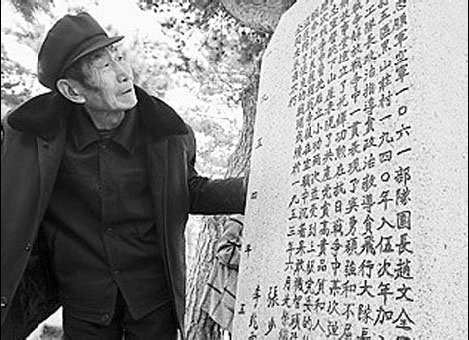|

Zhao Wenbao, visits the tomb of his brother Zhao Wenquan, one of 53 dead soldiers buried in a cemetery in Shenyang. File photo |
Leaning on the tombstone and sweeping it gently, Lin Guanghai, 68, murmurs: "Finally I have found you, dear brother. It's been nearly 60 years. May you rest in peace."
Lin's brother Lin Guangshan was a soldier who died in the Korean War (1950-1953).
Sixty years after the Chinese army's involvement in the war, journalists from Shenyang Daily found the families of 53 dead soldiers whose families had not been informed of their graves' whereabouts, after 42 months of traveling across 13 provinces and 200 cities in China.
It was on March 18, 2008, that journalist Fu Guiming from Shenyang Daily noticed the family information of 53 soldiers was missing when conducting an interview in the Martyrs Cemetery in Beiling Park of Shenyang, Liaoning province, neighboring the Democratic People's Republic of Korea, where 123 soldiers are buried.
Most of the families only received "martyr's certificates" but had no idea where their loved ones were buried. Some even thought they were buried in the DPRK.
"It's sad for both the martyrs and their loved ones," Fu says. Supported by the newspaper, Fu and his colleagues began a search for the soldiers' families.
The campaign proved extremely difficult. The soldiers' hometowns were hard to locate as they were spread over 13 provinces whose boundaries had changed many times, over decades. And most of the soldiers were from places that are still poor and remote.
The team then decided to take full advantage of media and the Internet. Sheyang Daily began a special column focusing on the search effort and sought the cooperation of local media to help narrow the search. Meanwhile, Fu and his team publicized the campaign on the Internet.
In April 2008, they found the first family member of one of the 53 soldiers - Lin Guanghai.
Soldier Fan Wanzhang's sister and brother learnt of the search from the Internet in Xinjiang Uygur autonomous region and went to Liaoning to identify their brother's tomb.
Over a year, the search yielded the whereabouts of the family members of 31 soldiers. By October this year, the families of the other 22 had also been located.
The team found that soldier Qi Jinhu's home was in Qianmiwen village in Laicheng county, Shandong province, and not Qianyu village as per the records. Soldier Liu Guangyi's hometown was also registered wrongly owing to a misunderstanding of the dialect.
"It was indeed exhausting," Fu says. "But worth it."
The story first appeared in People's Daily
China Daily
(China Daily 11/11/2010 page20)